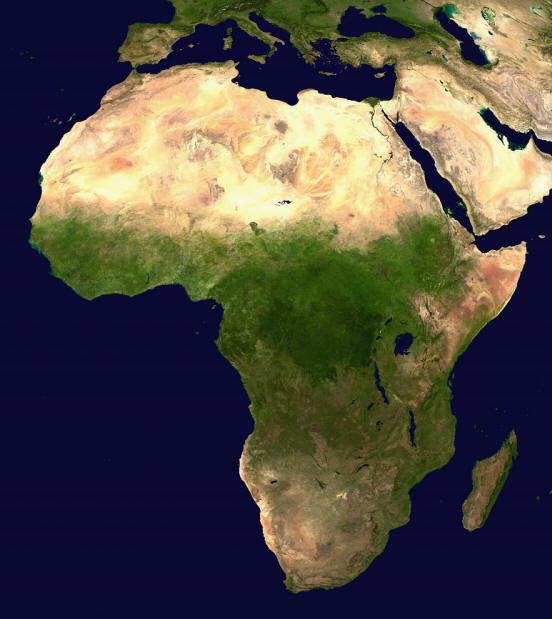|

The African Sahara Desert. Composite
satellite
image in
orthographic projection: Credit:
NASA.
The Sahara Desert
Apr 08, 2010
An extraterrestrial sand scar?
The light areas in the image
above show the wide swath of desert
area that extends across Africa, the
Middle East, and the entire Asian
continent. It encompasses many
deserts including the Sahara.
The
Sahara is the world's
largest hot desert. At over
9,000,000 square kilometres
(3,500,000 square miles), it covers
most of Northern Africa, making it
almost as large as the United States
or the continent of Europe. The
desert stretches from the Red Sea,
including parts of the Mediterranean
coasts, to the outskirts of the
Atlantic Ocean. Some of the sand
dunes can reach 180 meters (600 ft.)
in height. Mixed in with the oceanic
sands there are large rock
formations, boulders, stones and
pebbles. Some have compared areas of
the Sahara to the surface of Mars.
The sands of the Sahara hold many
secrets. It wasn’t always a vast
desolate ocean of sand; around 5,000
years ago it was a very different
terrain. It was a sub-tropical
paradise where deer, hippos and
elephants were hunted and giraffes
and rhinoceros roamed the area. With
a plentiful supply of food,
thousands of hunter-gatherers
flocked to live in this lush
savannah.
These facts are evident from the
discovery of hundreds of human
graves and numerous
rock paintings, depicting
people hunting and even swimming.
Furthermore, radar images taken by
the NASA space shuttle show that
beneath the sand are
networks of rivers, once
spanning the entire Sahara. North
Africa was once alive with people!
What happened to this lush green
world?
It was initially believed the
Sahara died out abruptly about 5,000
years ago. However, recent studies
have supposedly shown this to be
incorrect. Conventional scientists
believe the process took about three
millennia as reported by
Reuters in May 2008.
“The once-green Sahara turned to
desert over thousands of years
rather than in an abrupt shift as
previously believed, according to a
study on Thursday that may help
understanding of future climate
changes. The study of ancient
pollen, spores and aquatic organisms
in sediments in Lake Yoa in northern
Chad showed the region gradually
shifted from savannah 6,000 years
ago towards the arid conditions that
took over about 2,700 years ago. The
findings, about one of the biggest
environmental shifts of the past
10,000 years, challenge past belief
based on evidence in marine
sediments that a far quicker change
created the world's biggest hot
desert.”
Sand
Sand is the result of finely
weathered and eroded rock. It is
believed it takes tens of thousands,
if not millions of years for exposed
rock to weather into sand. The
longer this erosion takes place, the
finer the grains. The sand in the
Sahara is some of the oldest on the
planet; it is believed to have
existed for seven million years.
Some of the sand dunes are rich in
iron ore. The impurities stain the
quartz particles, which accounts for
their yellow colour.
Where did the Sahara sand come
from? It did not exist 6,000 years
ago. Experts are proposing that vast
oceans of sand formed in less than
3,300 years. This is impossible
because Saharan sand is some of the
oldest on the planet. Putting this
into context means that an area the
size of the US has been covered in a
vast sea of sand in what has to be
the blink of an eye in geological
terms. This makes no sense because
the time frame for the formation of
the sand does not allow it according
to consensus theories. If the
adjoining deserts swathing out
across the Middle East and Asia are
also considered, this equates to an
area twice the size of the US. Where
did all this sand come from?
Is it possible the earth is
covered with debris from recent
cosmic catastrophe? Could debris
such as large boulders, rocks,
stones, pebbles, dust and sand which
are believed to be indigenous to
Earth actually be extraterrestrial
in origin?
Wall Thornhill speaking on "Coast
to Coast" November 26, 2007:
“When you have an highly charged
object like a comet coming towards
the earth, before it strikes the
earth there will be an electrical
discharge between the two bodies and
that discharge will usually be of
sufficient magnitude to destroy the
incoming object - so you end up with
a shower of sand and stuff like
that."
"The famous
Chicago fires where that
whole area of the US was lit by
strange fires and falls of sand and
such like. And this occurred at the
time of the disappearance of
Biela's comet."
Countless tons of rocks bombarded
Earth’s atmosphere, fragmenting and
breaking up into fine grains of
sand. As it fell to Earth it covered
vast areas of once-lush, green
fertile land, turning it into the
barren deserts we see today.
This sand forms a gigantic scar
across the landscape which suggests
great swarms of debris were hurled
at the Earth, and the enormous
quantities of sand demonstrates the
extent of this bombardment.
Contributed by Gary Gilligan
http://gks.uk.com/
|







